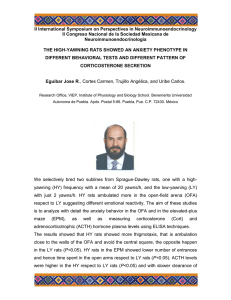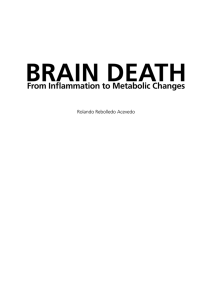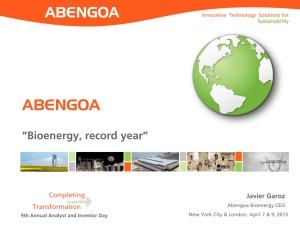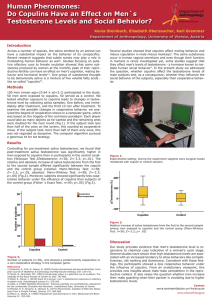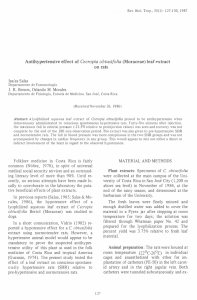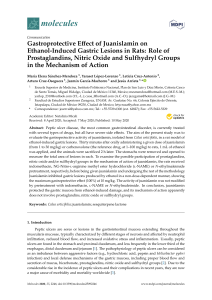Discontinuous vs. continuous drinking of ethanol
Anuncio
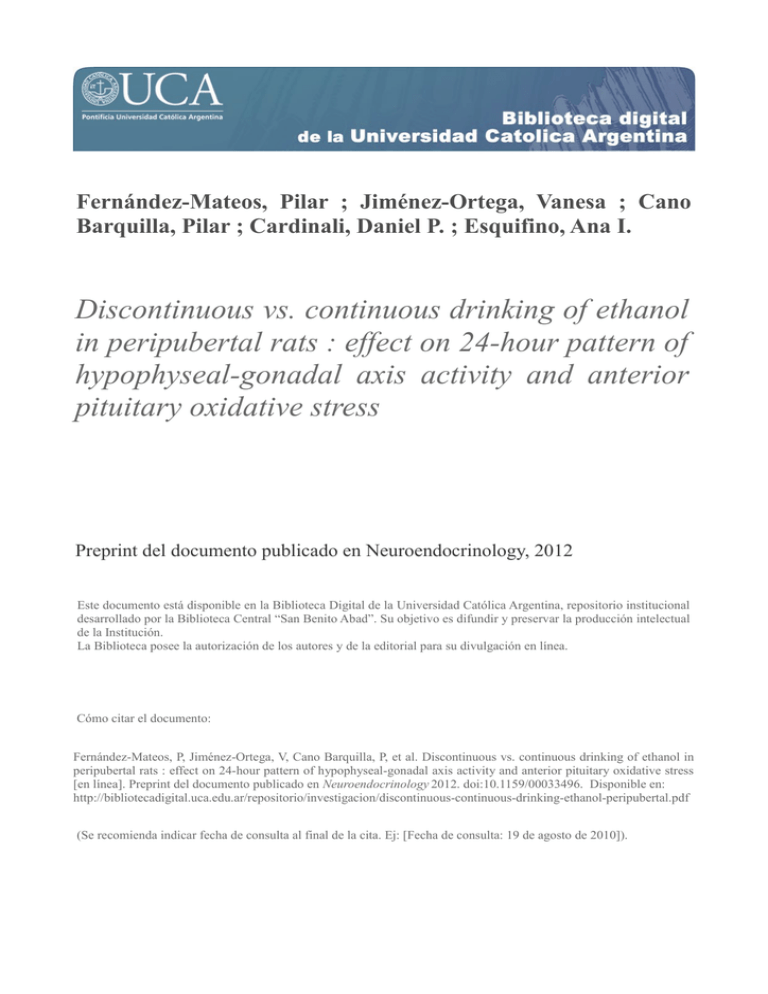
Fernández-Mateos, Pilar ; Jiménez-Ortega, Vanesa ; Cano Barquilla, Pilar ; Cardinali, Daniel P. ; Esquifino, Ana I. Discontinuous vs. continuous drinking of ethanol in peripubertal rats : effect on 24-hour pattern of hypophyseal-gonadal axis activity and anterior pituitary oxidative stress Preprint del documento publicado en Neuroendocrinology, 2012 Este documento está disponible en la Biblioteca Digital de la Universidad Católica Argentina, repositorio institucional desarrollado por la Biblioteca Central “San Benito Abad”. Su objetivo es difundir y preservar la producción intelectual de la Institución. La Biblioteca posee la autorización de los autores y de la editorial para su divulgación en línea. Cómo citar el documento: Fernández-Mateos, P, Jiménez-Ortega, V, Cano Barquilla, P, et al. Discontinuous vs. continuous drinking of ethanol in peripubertal rats : effect on 24-hour pattern of hypophyseal-gonadal axis activity and anterior pituitary oxidative stress [en línea]. Preprint del documento publicado en Neuroendocrinology 2012. doi:10.1159/00033496. Disponible en: http://bibliotecadigital.uca.edu.ar/repositorio/investigacion/discontinuous-continuous-drinking-ethanol-peripubertal.pdf (Se recomienda indicar fecha de consulta al final de la cita. Ej: [Fecha de consulta: 19 de agosto de 2010]). (Publicado en Neuroendocrinology, 2012, DOI: 10.1159/000334963) Discontinuous vs. Continuous Drinking of Ethanol in Peripubertal Rats: Effect on 24-Hour Pattern of Hypophyseal-Gonadal Axis Activity and Anterior Pituitary Oxidative Stress. Pilar Fernández-Mateosa,b Vanesa Jiménez-Ortegaa Pilar Cano Barquillaa Daniel P. Cardinalic,d Ana I. Esquifinoa a Department of Biochemistry and Molecular Biology III, Faculty of Medicine, Universidad Complutense, Madrid 28040, Spain. b Department of Cellular Biology, Faculty of Medicine, Universidad Complutense, Madrid 28040, Spain c Department of Teaching & Research, Faculty of Medical Sciences, Pontificia Universidad Católica Argentina, 1107 Buenos Aires, Argentina. d Department of Physiology, Faculty of Medicine, University of Buenos Aires, 1121 Buenos Aires, Argentina. Corresponding Author: Dr. D.P. Cardinali, Director, Departamento de Docencia e Investigación, Facultad de Ciencias Médicas, Pontificia Universidad Católica Argentina, Av. Alicia Moreau de Justo 1500, 4o piso 1107 Buenos Aires, Argentina. Tel: +54 11 43490200 ext 2310 E-mail: [email protected]; [email protected] Abbreviated title: Discontinuous vs. continuous drinking of alcohol Key Words: Chronic alcohol – Alcoholism - HPG axis – Reproduction - Prolactin – TSH - Libido Anterior pituitary - Oxidative stress – clock genes. 1 Abstract Aims. Discontinuous (weekend) consumption of alcohol is common in adolescents and young adults. This study therefore assesses, in peripubertal male rats, the effect of discontinuous as compared to chronic feeding of ethanol or control liquid diet. Methods. Animals received an ethanol liquid diet (6.2 % wt/vol) starting on day 35 of life. Every week for 5 weeks, the discontinuous ethanol group received the ethanol diet for 3 consecutive days and the control liquid diet for 4 days. At the 5th week, 24 h after the last ethanol administration to the discontinuous ethanol treated animals, rats were killed at 4 h intervals beginning at 0900 h. Chronically administered rats received the ethanol diet until immediately before study. Results. Disrupted 24-h rhythmicity together with a significant nocturnal increase in plasma luteinizing hormone (LH), testosterone and prolactin (PRL) occurred in the discontinuous ethanol group. Plasma ethanol levels were undetectable at 24 h after the last ethanol treatment. In contrast, after chronic ethanol administration, plasma PRL was increased late in scotophase while LH and testosterone decreased; blood ethanol levels were 2-fold greater than those in discontinuously ethanoladministered rats killed immediately after ethanol withdrawal. Circulating testosterone positively correlated with LH levels in control rats only. Chronic administration of ethanol significantly augmented mean expression of pituitary nitric oxide synthase (NOS)-2, heme oxygenase (HO)-1, Per1 and Per2 genes and disrupted their diurnal rhythmicity. Decreased NOS-1 and NOS-2 expression during scotophase, together with suppression of the rhythm in Per1 and Per2 expression, were found in the discontinuous ethanol group. Conclusions. Abstinence after discontinuous drinking of alcohol in rats, as compared to chronic administration of ethanol, is accompanied by increases of plasma LH and testosterone, a greater PRL response and a less pronounced oxidative damage of the anterior pituitary. Introduction The effect of ethanol on the hypothalamic pituitary-gonadal (HPG) axis has been extensively studied [1;2]. Although the acute effect of a high dose of ethanol has generally been a decrease in testosterone levels in male rats [3-5], in other studies [6], testosterone elevations were observed after giving a high dose of ethanol. Low doses of ethanol have been reported to elevate [4], to reduce [3;7], or not to alter testosterone levels in male rats [5]. Because a significant proportion of the adolescent and young adult populations tend to consume alcohol at weekends in a discontinuous pattern [8;9], studies on the effects of alcohol exposure on the adolescent neuroendocrine system using chronic alcohol feeding models in animals would probably fail to give information on the consequences of such a drinking behavior. We recently examined, as an experimental model for discontinuous ethanol feeding, the abstinence period of 24 h following the administration to peripubertal male rats of a liquid diet containing a moderate amount of ethanol, 3 days every week [10]. 2 Rats receiving the discontinuous ethanol diet exhibited impaired mitogenic responses in lymph node and splenic cells, a decreased number of lymph node and splenic CD8+ and CD4+-CD8+cells, and an augmented number of lymph node T cells and splenic T and B cells, as compared to those with chronic ethanol feeding or to control rats. Both modalities of ethanol administration disrupted the 24 h rhythm in the immune parameters examined [10]. As a follow up of that study we hereby report, also in peripubertal male rats, the effect of discontinuous feeding of ethanol as compared with continuous ethanol administration or control diet, taking as end points the 24-h variations of plasma luteinizing hormone (LH), testosterone, prolactin (PRL) and thyroid-stimulating hormone (TSH), as well as the anterior pituitary expression of nitric oxide synthase (NOS)-1 and 2 and heme oxygenase (HO)-1 genes and of Per1 and Per2 clock genes. In the discontinuous ethanol group the rats were examined 24 h after the last administration of ethanol. The results further underline the differences in consequences of ethanol drinking between a discontinuous and a continuous regime of administration. Materials and Methods Animals and experimental design Five week-old, peripubertal, male Wistar rats were kept under standard conditions of controlled light (12:12 h light/dark schedule) and temperature (22 ± 2 °C). Light intensity was 200 lux. Prior to treatment, animals were randomly assigned to one of the following three treatment groups (with an n of 48 animals per group, chosen based on a power analysis performed using preliminary data): (a) control; (b) discontinuous ethanol diet; (c) chronic ethanol diet. A liquid diet mode of ethanol administration was employed [11;12]. Animals received the liquid diet, starting on day 35 of life. The diet contained an aqueous suspension of pulverized casein, l-methionine, vitamin mixture, mineral mixture, sucrose, xanthum gum, choline bitartrate, Celufil cellulose, corn oil and maltose. Percent composition of the diet was 35% fat, 18% protein and 47% carbohydrates. The ethanol-fed group received a similar diet except that maltose was replaced by 96% ethanol. Final ethanol concentration was 6.2% (wt/vol) and ethanol replacement was isocaloric providing about 36% of the total caloric content of the diet. For the discontinuous ethanol group, the rats received the ethanol diet 3 days/week, the remaining 4 days receiving the control liquid diet. Sodium saccharin (0.05 % wt/vol) was added to mask the ethanol taste; it was also included in the control diet, as well as in the non-alcohol diet of the discontinuous alcohol fed rats. Control and experimental diets were freshly made each day. Rats were caged in groups of 4 animals/cage and had access to the liquid diet ad libitum. Daily consumption of liquid diet (mL/rat, mean±S.D., average of 4 rats) was 46.9±8.3 (control), 44.8±8.3 (discontinuous ethanol); and 40.0 ±8.2 (chronic ethanol). All 3 rats began the liquid diet without ethanol 5 days before the study to allow the animals to become accustomed to the new diet. The care and use as well as all procedures involving animals were approved by the Institutional Animal Care Committee, Complutense University, Madrid. The study was in accordance with the guidelines of the Institutional Care and Use Committee of the National Institute on Drug Abuse, National Institutes of Health and the Guide for the Care and Use of Laboratory Animals [13] At the 5th week of treatment, rats were killed by decapitation at six 4-h time intervals throughout a 24-h cycle starting at 0900 h. While chronically administered rats received the alcohol diet until immediately before study, rats in the discontinuous ethanol group were killed beginning 24 h after the last ethanol administration. During the dark period animals were killed under red dim light. The anterior pituitary was removed, weighed and frozen at -80 °C until further assayed. Trunk blood was collected and plasma samples were obtained by centrifugation of blood at 1,500 x g for 15 min. EDTA (6 g/100 mL) was used as an anticoagulant. Samples were stored at –20 °C until further analysis. In an independent experiment to measure blood ethanol levels, rats kept on the different diets above described were killed at 0900 h. An additional group of animals fed with the discontinuous ethanol diet was killed immediately at the end of ethanol administration without abstinence. Blood ethanol levels were determined by colorimetric measurement of nicotinamide adenine dinucleotide (NAD) reduction using an alcohol concentration determination reagent set (Biolabo Reagents , Maizy, France, ref. 99029). Total trunk blood was collected and plasma samples were obtained by centrifugation of blood at 1,500 x g for 15 min. EDTA (6 g/100 mL) was used as an anticoagulant. Plasma samples were incubated in colorimetric reagent at 37 °C for 10 min and absorbance was read at 340 nm. Results are expressed as mg of ethanol/mL plasma. Hormone determination Plasma LH, PRL and TSH levels were measured by a homologous specific double antibody RIA, using materials kindly supplied by the NIDDK's National Hormone and Pituitary Program. The intra- and interassay coefficients of variations were 6-9%. Sensitivities of the RIAs were 45, 45 and 190 pg/mL for LH, PRL and TSH using the NIDDK rat FSH-RP-2, rat LH-RP-3, rat PRL RP-3 and ratTSH-RP-3, respectively. Results were expressed as ng/mL [14;15]. Plasma testosterone levels were measured using a commercial kit (ICN Pharmaceuticals, Inc., Costa Mesa, CA, USA). Sensitivity of the assay was 0.2 ng/mL and the intraassay coefficient of variation was 5%, as previously described [14]; results were expressed as ng testosterone/mL. Real-time Quantitative Polymerase Chain Reaction (qPCR) Total anterior pituitary RNA extraction was performed using the RNeasy protect mini kit and were analyzed using QuantiTec SYBR green kit (Qiagen, Hielden, Germany). The iScript™ cDNA Synthesis Kit (Bio-Rad Laboratories SA; Madrid) was used to synthesize cDNA from 1 μg of total RNA, according to the 4 manufacturer's protocol. The house keeping gene β-actin was used as a constitutive control for normalization. Reactions were carried out in the presence of 200 nM of specific primers for NOS-1, NOS-2, HO-1, Per1 and Per2. Primers were designed using Primer3 software (The Whitehead Institute, http://frodo.wi.mit.edu/cgi-bin/primer3/primer3_www.cgi) and are shown in Table 1. PCR reactions were carried out in an Eppendorf RealPlex Mastercycler (Eppendorf AG, Hamburg, Germany). The real-time qPCR reaction program included a 94 °C enzyme activation step for 2 min followed by 40 cycles of 95 °C denaturation for 15 sec, 60 °C annealing for 30 sec and 72 °C extension for 30 sec. Detection of fluorescent product was carried out at the end of the 72 °C extension period. Serial dilutions of cDNA from control anterior pituitaries were used to perform calibration curves in order to determine amplification efficiencies. For the primers used there were no differences between transcription efficiencies, the amount of initial cDNA in each sample being calculated by the 2-ΔΔCt method [16]. All samples were analyzed in triplicate and in three different measures. The fractional cycle at which the amount of amplified target became significant (Ct) was automatically calculated by the PCR device. To estimate whether alcohol treatment or time of day modified the expression of β-actin, PCR with serial dilutions of this housekeeping gene was performed. Ct did not vary significantly in a factorial ANOVA as a function of treatment (F= 1.32) or of time of day (F= 0.27), indicating the validity of employing β-actin as a housekeeping gene. Statistical analysis Statistical analysis of results was performed by a two-way factorial analysis of variance (ANOVA), a one-way ANOVA or a Student´s t test, as stated. Post-hoc Bonferroni tests were employed to show differences among groups. Curve estimation in regression analysis was made using SPSS software, version 19 (SPSS Inc., Chicago, ILL). P values lower than .05 were considered evidence for statistical significance. Results Figure 1 depicts changes in circulating LH, testosterone, PRL and TSH levels in rats under the discontinuous or chronic ethanol regimes and in controls along the 24-h span. A factorial ANOVA indicated significant 3.2-, 2.1- and 6.5-fold increases in mean plasma LH, testosterone and PRL levels in the discontinuous ethanol group (p< 0.0001, Bonferroni´s test) whereas mean LH and testosterone decreased by 66 and 61%, and plasma PRL augmented by 108 % in the chronic ethanol group (p< 0.02) (Table 2). As shown by the significant interactions “time of day x treatment” in the factorial ANOVA (Table 2) as well as by one-way ANOVAs within each experimental group (as shown in the legend to Fig. 1), a disrupted 24h rhythmicity was detected under both ethanol regimes, i.e., a nocturnal increase in plasma LH, testosterone and PRL levels was found in the discontinuous ethanol 5 group while increased plasma PRL and decreased LH and testosterone levels during the late scotophase were observed in the chronically administered group (Fig. 1). Mean plasma values of TSH did not differ significantly among groups although significant interactions “treatment x time of day” were found in a factorial ANOVA, thus indicating that both modalities of ethanol administration disrupted the 24 h changes in circulating TSH observed in controls (Table 2, Fig. 1). Circulating testosterone positively correlated with LH levels in control rats only. This correlation was best described by a log model (r2 = 0.32, b0 = -0.18, b1 = 0.66, F = 5.51, p< 0.01, Fig. 2). Such a correlation was no longer observed in rats fed continuously or discontinuously with ethanol (F= 0.2 and 1.1, N.S., respectively). Figure 3 depicts the expression of NOS-1, NOS-2, HO-1, Per1 and Per2 genes in the anterior pituitary of the three groups of animals examined. The chronic administration of ethanol significantly augmented mean mRNA levels of NOS-2, HO-1, Per1 and Per2 as well as disrupting the 24-h rhythmicity in expression of the five genes examined, by inducing maxima at different times than controls in every case (Fig. 3 and Table 3). The discontinuous administration of ethanol decreased mean mRNA values of NOS-2 (p< 0.04) and disrupted NOS-1 and NOS-2 expression, by decreasing them significantly during the scotophase (p< 0.001, Fig. 3). It also suppressed the circadian variations in Per1 and Per2, while HO-1 expression remained unaffected (Fig. 3 and Table 3). Figure 4 shows the blood ethanol levels in an independent group of rats kept on the different diets above described and killed at 0900 h. An additional group of rats kept under the discontinuous ethanol diet but killed at the end of ethanol administration (no abstinence) was also examined. While blood ethanol was undetectable in control rats or in rats 24 h after interrupting the discontinuous ethanol regime, the ethanol levels detected after the chronic diet were about 2-fold higher than those found immediately after interruption of the discontinuous ethanol regime (p<0.0001, Student´s t test). The ethanol blood levels observed were within the range typically seen in alcoholic patients [17]. Discussion Binge drinking models have been achieved in rodents by repeated ethanol administration for 3 - 4 consecutive days using gastric gavage [18]. Although this strategy may reflect what happens to young people drinking alcohol at weekends, the intragastric administration of ethanol entails an important stress for the animal. Such a stress is minimized when complete liquid diets containing adjusted nutritional components and ethanol with approximately 36% of calories from ethanol are used (the Lieber–DeCarli diet [12]). The amounts of ethanol administered are moderate and the neuroendocrine sequela are expected to be subtle. Thus, examination of the effect of a discontinuous ethanol regime in peripubertal rats could give valuable information on neuroendocrine responses found during a moderate discontinuous way of ethanol intake in adolescent and young adults. In the present study we employed a liquid ethanol diet in order to monitor its effect on the 24-h organization of the neuroendocrine response in peripubertal rats to get an insight on the events taking place at a socially relevant time of human 6 ethanol-related behavior. Specifically, we wished to examine, in the discontinuous ethanol group, the abstinence period starting 24 h after the final administration of ethanol. Our results indicate that under this discontinuous ethanol regime, when ethanol concentration is undetectable in blood, disrupted diurnal rhythmicity with a significant nocturnal increase in plasma LH, testosterone and PRL levels took place. This contrasted significantly with the decreased LH and testosterone levels, and augmented plasma PRL levels, found in rats chronically fed with ethanol. Both modalities of ethanol administration disrupted the 24 h changes in circulating TSH. How ethanol acts on the HPG has been the subject of intensive investigation [1;2]. Although in male rats the acute effect of a high dose of ethanol is the reduction of testosterone secretion [3-5], other studies have reported elevations of testosterone [6]. Morever, testosterone levels of male rats given a low dose of ethanol (<1 g/kg, resembling those used in the present study) were reported to be elevated [4], reduced [3;7], or not altered at all [5]. It has been suggested that an ethanol-mediated testosterone surge may elevate brain β-endorphin concentrations and further promote ethanol drinking [3]. Although in the present experiments the Lieber–DeCarli liquid diet was employed in a discontinuous way to minimize the stress caused by the intragastric administration of ethanol used in the binge drinking models, the periodic ethanol feeding and withdrawal could still be a potent stressful situation as indicated by the 3-fold increase in mean plasma PRL levels observed. The increase in PRL, LH and testosterone seen after 24 h of abstinence from a liquid ethanol diet in the present experimental setting may well be linked to anticipatory stress rather than to a direct effect of ethanol, as shown by the non-detectable ethanol found in the discontinuously administered rats. Indeed, alcohol withdrawal is associated with persistent affective behavioral disturbance and several studies have reported both increased anxiety and reduced locomotor activity during withdrawal from chronic ethanol exposure in rats [19-22]. There is a consensus that PRL secretion is increased by stress [23-25], e.g, ether stress in male rats [26]. With respect to testosterone, it is interesting to note that in addition to the impressive amount of evidence supporting an inhibitory role of stress on testosterone secretion [27-33], there are also data indicating that testosterone levels in blood may increase at the initial stages of acute stress [see for example ref. [34]]. Since in some cases the increase of testosterone levels is unrelated to the circulating LH levels, the temporary rise in testosterone could be partly due to an increased testicular sensitivity to LH presumably via a local sympathetic stimulation [34]. In the present study circulating testosterone positively correlated with LH levels in control rats only. The loss of correlation between testosterone and LH in discontinuously or chronically ethanol-fed rats can be interpreted as indicating a direct effect on the testes as well. It has been suggested that free radical damage at the adenohypophysial level may be responsible for the decline in serum gonadotropin levels in rats fed with ethanol for 5 to 60 days [35]. There were increases in pituitary 8-oxodeoxyguanosine immunoreactivity, a marker of oxidative damage to nucleic acids, in malondialdehyde and 4-hydroxynonenal, markers of lipid peroxidation, and in pituitary protein carbonylation and nitrotyrosination, indexes of oxidative and nitrosative stress [35]. Potential oxidative and nitrosative stress effects on the anterior pituitary of rats chronically administered ethanol in a schedule similar to 7 that employed in the present study was previously shown by the increased gene expression of the prooxidant enzymes NOS-1 and 2 and HO-1 and the augmented levels of plasma NO2- and NO3- [36]. In the present study, the chronic ethanol feeding of peripubertal rats augmented pituitary NOS-2 and HO-1 mRNA levels and disrupted their 24-h pattern. Providing that gene expression data reflect actual changes in enzyme protein synthesis, the results suggest that the chronically elevated blood ethanol levels are causing an oxidative and nitrosative damage of the anterior pituitary. In contrast, during the abstinence period after a discontinuous administration of ethanol, with absent levels of ethanol in blood, decreased mean mRNA values of NOS-2 and disrupted NOS-1 and NOS-2 expression (i.e., significant decreases during the scotophase), are found. It must be noted that the study design makes it impossible to separate the anticipatory effects of the withdrawal of alcohol in the last 24 hours of the study, from the effects of the two modes of alcohol administration. Further studies by including withdrawal of both groups from ethanol 24 h before death, or alternatively, by killing the animals in the discontinuous group during a period of alcohol consumption are needed to unravel this point. On the basis of the 2-fold increase in ethanol levels found in chronically administered rats as compared to those of rats immediately after interruption of the discontinuous regime (no abstinence group) a more deleterious effect of chronic alcohol drinking could be expected. Presumably such a difference in circulating ethanol concentration was the result of the different degree of impairment of liver metabolism found in both groups. The biology of alcohol consumption displays a remarkable circadian organization in humans [37] and several aspects of this phenomenon can be reproduced in rodents. For example, rats and mice express pronounced daily rhythms in voluntary alcohol intake and time-dependent responses to ethanol [22;38-40]. Chronic ethanol administration influences various circadian rhythms (e.g. sleep, motor activity, food intake) [37;41]. Ethanol intake or withdrawal can disrupt the period of circadian rhythms, access to ethanol shortening the freerunning period in rats [42;43]. In addition, circadian rhythms modulate the response to ethanol and many other pharmacological substances. Previous data on the anterior hypophysis of rats under ad libitum solid diet indicated that the peak of Per1 and Per2 expression occurred at the beginning of the light phase, in antiphase with the peaks of Clock and Bmal1 expression [44]. The present results on anterior pituitary Per1 and Per2 expression in control animals under a liquid diet paradigm are in agreement with those observations. Such a pattern of expression of Per1 and Per2 became disrupted in discontinuously or chronically ethanol-fed rats, pointing to an effect of ethanol on the molecular mechanisms regulating circadian rhythmicity. It must be noted, however, that all experiments were done under entrained light-dark conditions (versus free running conditions in constant environments). Hence, further experiments are necessary to assess whether the changes in amplitude as well as in timing of 24-h hormone and gene expression rhythms hereby examined can be attributed either to an effect on the endogenous clock that modulates the circadian variation of pituitary or testicular release, or to a masking effect on some output(s) of the clock. One last aspect of the present paper deserves comment. Liquid diet paradigms may have a component of restricted calorie diet and therefore the 8 possibility that food presentation and availability would serve as a synchronizer for the circadian system must be considered. Food availability acts as a Zeitgeber resulting in e.g. “food anticipatory activity” among other phenomena [45;46]. In the present study, diet was made available ad libitum; thus, its action as a nonphotic Zeitgeber upon circadian rhythmicity is presumably small. However, some differences did occur in circulating hormone patterns when controls in the present experiment were compared with ad libitum solid diet-fed rats reported in previous studies. Although 24-h rhythmicity of plasma LH and testosterone reported in liquid fed control rats were generally similar to those found in solid diet-fed rats [47], in the case of PRL and TSH the main differences between animals fed a liquid diet and those fed laboratory chow were time shifts of peak concentrations in blood [14], presumably attributed to the mild stress caused by calorie restriction of liquid diet. In summary, excessive alcohol consumption continues to be a major public health problem in adolescent and young adults [48]. Our results suggest that the discontinuous drinking of a moderate amount of ethanol, at least in rats, is accompanied at the end of the ethanol-free interval by high levels of circulating testosterone. Since it has been suggested that a testosterone surge could further promote ethanol drinking [3] the possibility that discontinuous drinking of ethanol in humans is associated with higher levels of circulating testosterone which anticipate the next ethanol exposure and therefore a reinforcement of drinking behavior deserves to be examined. Whether the present observations in males can be extrapolated to female rats needs to be assessed before a fully understanding of the consequences of a discontinuous drinking of moderate amounts of ethanol by rodents is achieved. Acknowledgements This work was supported by grants from Ministerio de Interior, Plan Nacional sobre Drogas, Spain (PR201/02-11474), Programa de Creación y Consolidación de Grupos de Investigación, Universidad Complutense de Madrid (GR58/08), Agencia Nacional de Promoción Científica y Tecnológica, Argentina (PICT 2007-01045) and Universidad de Buenos Aires (M006). DPC is a Research Career Awardee from the Argentine Research Council and Emeritus Professor, University of Buenos Aires. The authors are indebted to Prof. Gregory M. Brown, Department of Psychiatry, Faculty of Medicine, University of Toronto, Toronto, Canada, for his valuable comments and grammar correction of the manuscript. 9 References [1] Emanuele MA, Emanuele N: Alcohol and the male reproductive system. Alcohol Res Health 2001;25:282-287. [2] Devaud LL, Risinger FO, Selvage D: Impact of the hormonal milieu on the neurobiology of alcohol dependence and withdrawal. J Gen Psychol 2006;133:337-356. [3] Apter SJ, Eriksson CJ: The effect of alcohol on testosterone concentrations in alcoholpreferring and non-preferring rat lines. Alcohol Clin Exp Res 2003;27:1190-1193. [4] Cicero TJ, Badger TM: Effects of alcohol on the hypothalamic-pituitary-gonadal axis in the male rat. J Pharmacol Exp Ther 1977;201:427-433. [5] Eriksson CJ, Widenius TV, Ylikahri RH, Harkonen M, Leinonen P: Inhibition of testosterone biosynthesis by ethanol. Relation to hepatic and testicular acetaldehyde, ketone bodies and cytosolic redox state in rats. Biochem J 15-1-1983;210:29-36. [6] Alomary AA, Vallee M, O'Dell LE, Koob GF, Purdy RH, Fitzgerald RL: Acutely administered ethanol participates in testosterone synthesis and increases testosterone in rat brain. Alcohol Clin Exp Res 2003;27:38-43. [7] Jimenez V, Cardinali DP, Cano P, Alvarez MP, Reyes Toso CF, Esquifino AI: Effect of ethanol on 24-hour hormonal changes in peripubertal male rats. Alcohol 2004;34:127-132. [8] Duka T, Gentry J, Malcolm R, Ripley TL, Borlikova G, Stephens DN, Veatch LM, Becker HC, Crews FT: Consequences of multiple withdrawals from alcohol. Alcohol Clin Exp Res 2004;28:233-246. [9] Stephens DN, Ripley TL, Borlikova G, Schubert M, Albrecht D, Hogarth L, Duka T: Repeated ethanol exposure and withdrawal impairs human fear conditioning and depresses long-term potentiation in rat amygdala and hippocampus. Biol Psychiatry 2005;58:392-400. [10] Jimenez-Ortega V, Fernandez MP, Cano P, Cardinali DP, Esquifino AI: Continuous vs. discontinuous drinking of an ethanol liquid diet in peripubertal rats: Effect on 24hour variation of lymph node and splenic mitogenic responses and lymphocyte subset populations. Alcohol 2011;45:183-192 [11] Dodd H, Shorey-Kutschke RL: Ethanol lowers heart carnitine in the methionine and choline deficient rat. Alcohol 1987;4:395-399. [12] Lieber CS, DeCarli LM: Animal models of chronic ethanol toxicity. Methods Enzymol 1994;233:585-594. [13] Institute of Laboratory Animal Resources CoLSNRC: Guide for the Care and Use of Laboratory Animals. Washington, D.C., National Academy Press, 1996. [14] Garcia Bonacho M, Esquifino AI, Castrillon P, Reyes Toso C, Cardinali DP: Age-dependent effect of Freund's adjuvant on 24-hour rhythms in plasma prolactin, growth hormone, thyrotropin, insulin, follicle-stimulating hormone, luteinizing hormone and testosterone in rats. Life Sci 2000;66:1969-1977. [15] Castrillón P, Cardinali DP, Pazo D, Cutrera RA, Esquifino AI: Effect of superior cervical ganglionectomy on 24-h variations in hormone secretion from anterior hypophysis and in hypothalamic monoamine turnover, during the preclinical phase of Freund's adjuvant arthritis in rats. J Neuroendocrinol 2001;13:288-295. [16] Livak KJ, Schmittgen TD: Analysis of relative gene expression data using real-time quantitative PCR and the 2-ΔΔCt method. Methods 2001;25:402-408. [17] Adachi J, Mizoi Y, Fukunaga T, Ogawa Y, Ueno Y, Imamichi H: Degrees of alcohol intoxication in 117 hospitalized cases. J Stud Alcohol 1991;52:448-453. [18] Nagy LE: Alcohol: Methods and Protocols. New Jersey, Humana Press, 2008. 10 [19] Overstreet DH, Knapp DJ, Moy SS, Breese GR: A 5-HT1A agonist and a 5-HT2c antagonist reduce social interaction deficit induced by multiple ethanol withdrawals in rats. Psychopharmacology (Berl) 2003;167:344-352. [20] Rasmussen DD, Mitton DR, Green J, Puchalski S: Chronic daily ethanol and withdrawal: 2. Behavioral changes during prolonged abstinence. Alcohol Clin Exp Res 2001;25:9991005. [21] Valdez GR, Roberts AJ, Chan K, Davis H, Brennan M, Zorrilla EP, Koob GF: Increased ethanol self-administration and anxiety-like behavior during acute ethanol withdrawal and protracted abstinence: regulation by corticotropin-releasing factor. Alcohol Clin Exp Res 2002;26:1494-1501. [22] Logan RW, Seggio JA, Robinson SL, Richard GR, Rosenwasser AM: Circadian wheel-running activity during withdrawal from chronic intermittent ethanol exposure in mice. Alcohol 2010;44:239-244. [23] Gala RR: The physiology and mechanisms of the stress-induced changes in prolactin secretion in the rat. Life Sci 1990;46:1407-1420. [24] Franci CR, Anselmo-Franci JA, McCann SM: The role of endogenous atrial natriuretic peptide in resting and stress-induced release of corticotropin, prolactin, growth hormone, and thyroid-stimulating hormone. Proc Natl Acad Sci U S A 1992;89:11391-11395. [25] Neill JD: Effect of "stress" on serum prolactin and luteinizing hormone levels during the estrous cycle of the rat. Endocrinology 1970;87:1192-1197. [26] Deis RP, Leguizamon E, Jahn GA: Feedback regulation by progesterone of stress-induced prolactin release in rats. J Endocrinol 1989;120:37-43. [27] Akinbami MA, Philip GH, Sridaran R, Mahesh VB, Mann DR: Expression of mRNA and proteins for testicular steroidogenic enzymes and brain and pituitary mRNA for glutamate receptors in rats exposed to immobilization stress. J Steroid Biochem Mol Biol 1999;70:143-149. [28] Andersen ML, Bignotto M, Machado RB, Tufik S: Different stress modalities result in distinct steroid hormone responses by male rats. Braz J Med Biol Res 2004;37:791-797. [29] Razzoli M, Roncari E, Guidi A, Carboni L, Arban R, Gerrard P, Bacchi F: Conditioning properties of social subordination in rats: behavioral and biochemical correlates of anxiety. Horm Behav 2006;50:245-251. [30] Biswas NM, Sen GR, Chattopadhyay A, Choudhury GR, Sarkar M: Effect of atenolol on cadmium-induced testicular toxicity in male rats. Reprod Toxicol 2001;15:699-704. [31] Hardy MP, Gao HB, Dong Q, Ge R, Wang Q, Chai WR, Feng X, Sottas C: Stress hormone and male reproductive function. Cell Tissue Res 2005;322:147-153. [32] Manna I, Jana K, Samanta PK: Intensive swimming exercise-induced oxidative stress and reproductive dysfunction in male wistar rats: protective role of alpha-tocopherol succinate. Can J Appl Physiol 2004;29:172-185. [33] Manna I, Jana K, Samanta PK: Effect of intensive exercise-induced testicular gametogenic and steroidogenic disorders in mature male Wistar strain rats: a correlative approach to oxidative stress. Acta Physiol Scand 2003;178:33-40. [34] Chichinadze K, Chichinadze N: Stress-induced increase of testosterone: contributions of social status and sympathetic reactivity. Physiol Behav 2008;94:595-603. [35] Ren JC, Banan A, Keshavarzian A, Zhu Q, Lapaglia N, McNulty J, Emanuele NV, Emanuele MA: Exposure to ethanol induces oxidative damage in the pituitary gland. Alcohol 2005;35:91-101. [36] Jimenez-Ortega V, Cardinali DP, Poliandri AH, Cano P, Reyes Toso C, Esquifino AI: 24-Hour rhythm in gene expression of nitric oxide synthase and heme-oxygenase in anterior pituitary of ethanol-fed rats. Neurosci Lett 2007;425:69-72. 11 [37] Spanagel R, Rosenwasser AM, Schumann G, Sarkar DK: Alcohol consumption and the body's biological clock. Alcohol Clin Exp Res 2005;29:1550-1557. [38] Baird TJ, Briscoe RJ, Vallett M, Vanecek SA, Holloway FA, Gauvin DV: Phase-response curve for ethanol: alterations in circadian rhythms of temperature and activity in rats. Pharmacol Biochem Behav 1998;61:303-315. [39] Trujillo JL, Do DT, Grahame NJ, Roberts AJ, Gorman MR: Ethanol consumption in mice: relationships with circadian period and entrainment. Alcohol 28-9-2010. [40] Clark JW, Fixaris MC, Belanger GV, Rosenwasser AM: Repeated light-dark phase shifts modulate voluntary ethanol intake in male and female high alcohol-drinking (HAD1) rats. Alcohol Clin Exp Res 2007;31:1699-1706. [41] Rosenwasser AM: Alcohol, antidepressants, and circadian rhythms. Human and animal models. Alcohol Res Health 2001;25:126-135. [42] Rosenwasser AM, Fecteau ME, Logan RW: Effects of ethanol intake and ethanol withdrawal on free-running circadian activity rhythms in rats. Physiol Behav 2005;84:537-542. [43] Rosenwasser AM, Logan RW, Fecteau ME: Chronic ethanol intake alters circadian periodresponses to brief light pulses in rats. Chronobiol Int 2005;22:227-236. [44] Cardinali DP, Cano P, Jimenez-Ortega V, Esquifino AI: Melatonin and the metabolic syndrome. Physiopathologic and therapeutical implications. Neuroendocrinology 2011;93:133142. [45] Challet E, Mendoza J: Metabolic and reward feeding synchronises the rhythmic brain. Cell Tissue Res 2010;341:1-11. [46] Carneiro BT, Araujo JF: The food-entrainable oscillator: a network of interconnected brain structures entrained by humoral signals? Chronobiol Int 2009;26:1273-1289. [47] Esquifino AI, Chacon F, Jimenez V, Reyes Toso C, Cardinali DP: 24-Hour changes in circulating prolactin, follicle-stimulating hormone, luteinizing hormone and testosterone in male rats subjected to social isolation. J Circad Rhythms 2004;2:1. [48] Stolle M, Sack PM, Thomasius R: Binge drinking in childhood and adolescence: epidemiology, consequences, and interventions. Dtsch Arztebl Int 2009;106:323-328. 12 FIGURE LEGENDS Figure 1. Effect of a continuous or discontinuous drinking of ethanol on 24-h changes in plasma LH, testosterone (T), PRL and TSH of peripubertal rats. Groups of 8 rats subjected to a discontinuous ethanol liquid diet, a chronic ethanol liquid diet or to a control liquid diet as described in Methods, were killed by decapitation at 6 different time intervals throughout a 24 h cycle. Bar indicates scotophase duration. Shown are the means ± SEM. Significant differences among groups at the given time interval after a one-way ANOVA followed by a Bonferroni multiple comparison test are indicated as follows: * p< 0.01 vs. the remaining groups; ** p< 0.02 vs. control. One-way ANOVAs within each experimental group indicated significant time-related changes in hormone concentration as follows: Control: LH, testosterone, PRL and TSH (F =4.34, p <0.005, F = 4.71, p <0.003, F =48.8, p <0.0001, and F =8.78, p <0.0001, respectively). Discontinuous ethanol: LH, testosterone and PRL (F =3.98, p <0.01, F =5.94, p <0.001 and F =11.1 p <0.0001, respectively). Chronic ethanol: LH, testosterone, PRL and TSH (F =22.8, 77.7, 9.31 and 10.9, p <0.0001, respectively). Letters designate significant differences among time intervals within each experimental group in a post-hoc Bonferroni multiple comparison test, as follows: a p< 0.02 vs. 0900 h; b p< 0.02 vs. all time intervals; c p< p< 0.02 vs. 0100 and 0900 h; d p< 0.02 vs. 0900 h; e p< 0.01 vs. 0900, 1300, 1700 and 2100 h; f p< 0.02 vs. 0900, 1300 and 1700 h; g p< 0.02 vs. 0900 and 2100 h. For further statistical analysis, see text. Figure 2. Scatter diagrams of plasma testosterone (T) plotted against plasma LH concentration in rats fed the control liquid diet, the chronic ethanol liquid diet or the discontinuous ethanol liquid diet. Under the control liquid diet, the correlation was significant and was best described by a log model (r2 = 0.32, b0 = -0.18, b1 = 0.66, F = 5.51, p< 0.01). N.S.: not significant. Figure 3. Effect of a continuous and discontinuous ethanol on 24 h changes in expression of anterior pituitary NOS-1, NOS-2, HO-1, Per1 and Per2 genes of peripubertal rats. Groups of 8 rats, subjected to a discontinuous ethanol liquid diet, a chronic ethanol liquid diet or to a control liquid diet as described in Methods, were killed by decapitation at 6 different time intervals throughout a 24 h cycle. mRNA levels were measured as described in the text. Shown are the means ± SEM of mRNA determination as measured by triplicate real-time PCR analyses of RNA samples. Significant differences among groups at the given time interval after a one-way ANOVA followed by a Bonferroni multiple comparison test are indicated as follows: * p< 0.01 vs. the remaining groups; ** p< 0.02 vs. control; # p< 0.05 vs. control; ¤ p< 0.02 vs. discontinuous ethanol. One-way ANOVAs within each experimental group indicated significant time-related changes in gene expression as follows: Control: NOS-1, NOS-2, HO-1, Per1 and Per2 (F =25.9, p <0.0001, F 13 =17.2, p <0.0001, F =4.06, p <0.01, F=5,63, p <0.002 and F=23.4, F= p <0.0001, respectively). Discontinuous ethanol: NOS-2 and HO-1 (F =2.87, p <0.04, and F =8.21, p <0.0001, respectively). Chronic ethanol: NOS-1, NOS-2, HO-1, Per1 and Per2 (F =93.5, 40.3, 91.2, 245 and 66.6, p <0.0001, respectively). Letters designate significant differences among time intervals within each experimental group in a post-hoc Bonferroni multiple comparison test, as follows: a p< 0.01 vs. 0900, 1300, 1700 and 2100 h; b p< 0.01 vs. all time intervals; c p< 0.02 vs. 0100, 0900 and 1300 h; d p< 0.02 vs. 0900, 1300 and 1700 h; e p< 0.02 vs. 0500 and 1700 h; f p< 0.01 vs. 0100, 0500, 1700 and 2100 h; g p< 0.02 vs. 0500, 1700 and 2100 h; h p< 0.02 vs. 0900 and 2100 h. For further statistical analysis, see text. Figure 4. Effect of a continuous and discontinuous ethanol on plasma levels of ethanol in peripubertal rats. In this independent experiment an additional group of rats kept under the discontinuous ethanol diet but killed at the end of ethanol administration (no abstinence) was included. Rats (n= 8/group) were killed at 0900 h. Plasma ethanol levels were determined colorimetrically by measuring of NAD reduction at 340 nm as described in Methods. Shown are the means ± SEM. ** p< 0.001 vs. chronic ethanol, Student´s t test. N.D.: undetectable levels. 14 15 16 17 18 Table 1. Sequence of the primers used for real-time PCR Gene Primers β- Actin Forward Product Size (bp) ctctcttccagccttccttc Backward ggtctttacggatgtcaacg NOS-1 Forward atcggcgtccgtgactactg Backward tcctcatgtccaaatccatcttcttg NOS-2 Forward tggcctccctctggaaaga Backward ggtggtccatgatggtcacat HO-1 Forward tgctcgcatgaacactctg Forward ggctccggtacttctctttc Backward aataggggagtggtcaaagg Per2 Forward 92 93 123 Backward tcctctgtcagcagtgcc Per1 99 acacctcatgagccagacat Backward ctttgactcttgccactggt 19 106 99 Table 2. Summary of factorial ANOVA for data of Fig. 1. Source Group Time Group x Time Error d.f. 2 5 10 LH F 202 4.53 2.21 P < 0.001 <0.01 <0.02 testosterone F P 18.6 < 0.001 6.92 < 0.001 3.91 < 0.001 PRL F 139 17.6 6.52 P < 0.001 < 0.001 < 0.001 TSH F 0.39 1.37 3.44 P n.s. n.s. <0.01 130 Control Discontinuous ethanol Chronic ethanol Mean hormone levels (ng/mL plasma) ± SEM 0.38 ± 0.02** 1.33 ± 0.09** 2.96 ± 0.21** 1.25 ± 0.08** 2.76 ± 0.31** 19.4 ± 1.69** 2.55 ± 0.07 2.44 ± 0.21 0.13 ± 0.01** 2.39 ± 0.07 0.52 ± 0.05** ** p< 0.01 vs. the remaining groups, Bonferroni´s test 20 6.15 ± 0.96** Table 3. Summary of factorial ANOVA for data of Fig. 3. Source Group Time Group x Time Error d.f. 2 5 10 NOS-1 F P 1.35 n.s. 4.56 <0.01 6.75 <0.001 NOS-2 F P 114 < 0.001 26.2 < 0.001 19.7 < 0.001 HO-1 F 197 86.7 65.8 P < 0.001 < 0.001 < 0.001 Per1 F 34.9 24.7 16.1 P <0.001 <0.001 <0.001 Per2 F 32.7 20.2 19.8 P <0.001 <0.001 <0.001 55 Control Discontinuous ethanol Chronic ethanol 1.45 ± 0.14 1.31 ± 0.17 1.16 ± 0.19 Mean relative gene expression ± SEM 0.56 ± 0.07 1.10 ± 0.06 0.72 ± 0.11 0.59 ± 0.07 2.21 ± 0.30a 3.97 ± 0.82a a 0.72 ± 0.05 1.37 ± 0.17 1.31 ± 0.08 0.94 ± 0.11 1.83 ± 0.34b 1.79 ± 0.35c p< 0.01 vs. the remaining groups; b p< 0.01 vs. control,; c p< 0.05 vs. discontinuous ethanol, Bonferroni´s test 21

